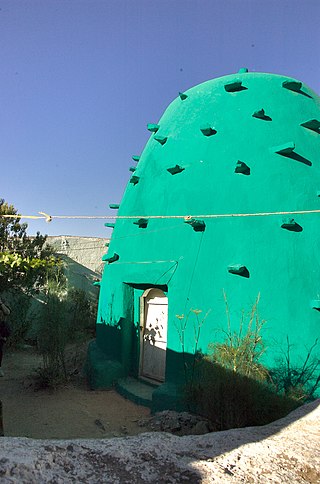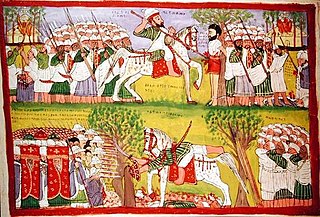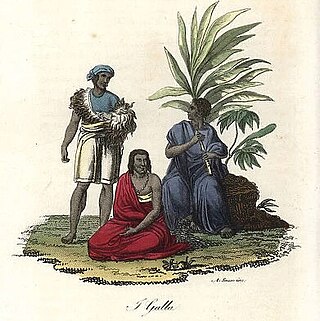
Harar, known historically by the indigenous as Harar-Gey or simply Gey, is a walled city in eastern Ethiopia. It is also known in Arabic as the City of Saints.

The Adal Sultanate also known as the Adal Empire, or Bar Saʿad dīn was a medieval Sunni Muslim Empire which was located in the Horn of Africa. It was founded by Sabr ad-Din III on the Harar plateau in Adal after the fall of the Sultanate of Ifat. The kingdom flourished c. 1415 to 1577. At its height, the polity under Sultan Badlay controlled the territory stretching from Cape Guardafui in Somalia to the port city of Suakin in Sudan. The Adal Empire maintained a robust commercial and political relationship with the Ottoman Empire. Sultanate of Adal was alternatively known as the federation of Zeila.

The Sultanate of Ifat, known as Wafāt or Awfāt in Arabic texts, or the Kingdom of Zeila was a medieval Sunni Muslim state in the eastern regions of the Horn of Africa between the late 13th century and early 15th century. It was formed in present-day Ethiopia around eastern Shewa in Ifat. Led by the Walashma dynasty, the polity stretched from Zequalla to the port city of Zeila. The kingdom ruled over parts of what are now Ethiopia, Djibouti and Somaliland.
The Walashma dynasty was a medieval Muslim dynasty of the Horn of Africa founded in Ifat. Founded in the 13th century, it governed the Ifat and Adal Sultanates in what are present-day Somaliland, Somalia, Djibouti, Eritrea and eastern Ethiopia.
Hadiya also known as Adea or Hadia was a medieval Muslim state in the southern part of its realm located south of Shewa and west of Sharkha. The Hadiya Muslim state mainly composed of Cushitic Hadiyya proper, Halaba, Kebena people as well as Semitic Sil'te and other tongues related to Harari language. Hadiya was historically a vassal state of the Adal federation and then became an autonomous province of Abyssinia in the fourteenth century while still remaining a member of the Zeila union. In the 1600s Hadiya regained its independence and was led by a Garad. By 1850, Hadiya is placed north-west of lakes Zway and Langano but still between these areas.
Hadiya, also spelled as Hadiyya, is an ethnic group native to Ethiopia in Southern Nations, Nationalities and Peoples' Region who speak the Hadiyyisa language. According to a popular etymology, the name 'Hadiyya," sometimes written in the versions Hadya, Hadea, Hadija, Hadiyo, Hadiyeh, Adea, Adia, means "gift of god" A historical definition of the Hadiya people based on the old Hadiyya Sultanate included a number of Ethiopian ethnic groups currently known by other names. Currently, this historic entity is subdivided into a number of ethnonyms, partly with different languages and cultural affiliations. In his book "A History of the Hadiyya in Southern Ethiopia," Ulrich Braukämper reported that Leemo, Weexo-giira, Sooro, Shaashoogo, Baadawwaachcho, and Libido (Maraqo) Hadiyya, Endegang subgroups remain a language entity and preserved identity of oneness, the Hadiyya proper. The term Hadiya specifically designates the Qabeena people. Other ethnic groups such as Siltʼe, Wulbareg, Azarnat, Barbare, Wuriro, Wolane and Gadabano profess that they're the seven Hadiya clans. Ancient Hadiyans are distinguished by their Muslim heritage however these populations have decreased in the following centuries. Clans of Hadiya origin in Oromia, Sidama, Wolayta, Gurage, Tigray, and Afar were completely absorbed by these nations. They were initially all inhabitants of a single political entity, a sultanate, which in the four centuries following its break-up in the mid-16th century fragmented into separate ethnic groups.

Nur al-Din or Nur ibn Mujahidibn ‘Ali ibn ‘Abdullah al Dhuhi Suha was an Emir of Harar who ruled over the Adal Sultanate. He was known for marrying his uncle's widow, Bati del Wambara, and he also succeeded Imam Ahmad as leader of the Muslim forces fighting Christian Ethiopia. He is often known as the "King of Adel" in medieval texts.

The Ethiopian–Adal War or Abyssinian–Adal War, also known in Arabic as the "Futuḥ al-Ḥabash", was a military conflict between the Christian Ethiopian Empire and the Muslim Adal Sultanate from 1529 to 1543. The Christian Ethiopian troops consisted of the Amhara, Tigrayans, Tigrinya and Agaw people, and at the closing of the war, supported by a few hundred Portuguese musketmen. Whereas Adal forces were mainly composed of Harla, Somali, Afar, as well as Arab and Turkish gunmen. Both sides at times would see the Maya mercenaries join their ranks.
The Argobba are an ethnic group inhabiting Ethiopia. A Muslim community, they are spread out through isolated village networks and towns in the north-eastern and eastern parts of the country. Group members have typically been astute traders and merchants, and have adjusted to the economic trends in their area. These factors have led to a decline in usage of the Argobba language. Argobba are considered endangered today due to exogamy and destitution as well as ethnic cleansing by the Abyssinian state over the centuries.

The Harari people are a Semitic-speaking ethnic group which inhabits the Horn of Africa. Members of this ethnic group traditionally reside in the walled city of Harar, simply called Gēy "the City" in Harari, situated in the Harari Region of eastern Ethiopia. They speak the Harari language, a member of the South Ethiopic grouping within the Semitic subfamily of the Afroasiatic languages.
The Harla, also known as Harala, Haralla are an ethnic group that once inhabited Ethiopia, Somalia, and Djibouti. They spoke the now-extinct Harla language, which belonged to either the Cushitic or Semitic branches of the Afroasiatic family.

The Oromo expansions, also known as the Oromo migrations or the Oromo invasions, were a series of expansions in the 16th and 17th centuries by the Oromo. Prior to their great expansion in the 16th century, the Oromo inhabited only the area of what is now modern-day southern Ethiopia and northern Kenya. Over the centuries due to many factors, mostly the wars between Adal Sultanate and Ethiopia would further encourage the numerous Oromo tribes to expand towards central and eastern modern Ethiopia.

The Makhzumi dynasty also known as Sultanate of Shewa or Shewa Sultanate, was a Muslim kingdom in present-day Ethiopia. Its capital Walale was situated in northern Hararghe in Harla country. Its territory extended possibly to some areas west of the Awash River. The port of Zeila may have influenced the kingdom. The rise of the Makhzumi state at the same time resulted in the decline of the Kingdom of Axum. Several engravings dating back to the 13th century showing the presence of the kingdom are found in Chelenqo, Bale, Harla near Dire Dawa and Munesa near Lake Langano.
The Imamate of Aussa, also spelled Imamate of Awsa, was a medieval Sunni Muslim imamate in present-day eastern Ethiopia and north-western Djibouti. Muhammad Gasa established the seat of power to Aussa from Harar in 1577, as the latter was too exposed to Oromo invasions. Internal strife arose from conflicts between the Harla and Arab factions. A Harar faction split from the Imamate in 1647 forming their own independent emirate. The 17th century saw the inclusion of upland Harla and Doba populations playing a pivotal role in the establishment of the Aussa Sultanate. The state was disestablished in 1734 and in 1769, the Mudaito dynasty successfully overthrew the Kabirto of Harla.

Timothy Insoll is a British archaeologist and Africanist and Islamic Studies scholar. Since 2016 he has been Al-Qasimi Professor of African and Islamic Archaeology at the University of Exeter. He is also founder and director of the Centre for Islamic Archaeology. Previously he was at the Department of Archaeology at the University of Manchester (1999–2016).
The Gaturi, also spelled as Gatouri are an extinct ethnic group that once inhabited present-day eastern Ethiopia.

Hubat, also known as Hobat, or Kubat was a historical Muslim state located in present-day eastern Ethiopia. Historically part of the Adal region alongside Gidaya and Hargaya states on the Harar plateau. Hubat is today within a district known as Adare Qadima which includes Garamuelta and its surroundings in Oromia region. The area is 30 km north west of Harar city at Hubeta, according to historian George Huntingford. Trimingham locates it as the region between Harar and Jaldessa. Archaeologist Timothy Insoll considers Harla town to be Hubat the capital of the now defunct Harla Kingdom.

Gidaya, also known as Gedaya or Jidaya was a historical Muslim state located around present-day eastern Ethiopia. The state was positioned on the Harar plateau and a district of Adal region alongside Hargaya and Hubat polities. It neighbored other states in the medieval era including Ifat, Mora, Hadiya, Fatagar, Biqulzar and Fedis.
Adal, known as Awdal or Aw Abdal was a historical Muslim region in the Horn of Africa. Located east of Ifat and the Awash river as far as the coast, and including Harar as well as Zeila. The Zeila state often denoted Adal and other Muslim dominions in medieval texts.

Ifat also known as Yifat, Awfat or Wafat was a historical Muslim region in the Horn of Africa. It was located on the eastern edge of Shewa.











